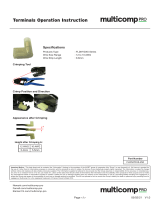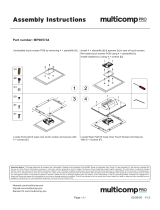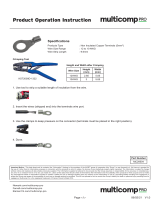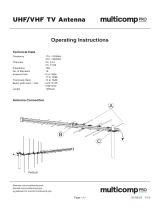Page is loading ...

Evaluation Board User Guide
UG-108
One Technology Way • P. O. Box 9106 • Norwood, MA 02062-9106, U.S.A. • Tel: 781.329.4700 • Fax: 781.461.3113 • www.analog.com
Evaluation Board for the Integer-N PLL Frequency Synthesizer
PLEASE SEE THE LAST PAGE FOR AN IMPORTANT
WARNING AND LEGAL TERMS AND CONDITIONS. Rev. A | Page 1 of 24
FEATURES
General-purpose PLL evaluation board excluding VCO, loop
filter, and TCXO
Contains ADF4002 400 MHz frequency synthesizer IC
Accompanying software allows complete control of
synthesizer functions from a PC
EVALUATION KIT CONTENTS
EV-ADF4002SD1Z board
CD that includes
Self-installing software that allows users to control the
board and exercise all functions of the device
Electronic version of the ADF4002 data sheet
Electronic version of the UG-108 user guide
ADDITIONAL EQUIPMENT
PC running Windows XP or more recent version
SDP-S board (system demonstration platform, serial only)
T-package VCO
0805 resistors and capacitors
Spectrum analyzer
Oscilloscope (optional)
DOCUMENTS NEEDED
ADF4002 data sheet
REQUIRED SOFTWARE
Analog Devices Int-N software (Version 7 or higher)
ADIsimPLL
GENERAL DESCRIPTION
This board is designed to allow the user to evaluate the perfor-
mance of the ADF4002 frequency synthesizer for phase-locked
loops (PLLs). Figure 1 shows the board, which contains the
footprint for an ADF4002 synthesizer, an SMA connector for
the reference input, power supplies, and an RF output. There is
also a footprint for a loop filter and a VCO on board.
The evaluation kit also contains software that is compatible with
Windows® XP and later versions to allow easy programming of
the synthesizer.
This board requires an SDP-S (system demonstration platform-
serial) board (shown in Figure 1, but not supplied with the kit).
The SDP-S allows software programming of the ADF4002 device.
EVALUATION BOARD
Figure 1. EV-ADF4002SD1Z with SDP-S
08896-001

UG-108 Evaluation Board User Guide
Rev. A | Page 2 of 24
TABLE OF CONTENTS
Features .............................................................................................. 1
Evaluation Kit Contents ................................................................... 1
Additional Equipment ..................................................................... 1
Documents Needed .......................................................................... 1
Required Software ........................................................................ 1
General Description ......................................................................... 1
Evaluation Board .............................................................................. 1
Revision History ............................................................................... 2
Quick Start Guide ............................................................................. 3
Evaluation Board Hardware ............................................................ 4
Power Supplies .............................................................................. 4
Input Signals .................................................................................. 4
Output Signals ...............................................................................4
Default Operation and Jumper Selection Settings ....................5
System Demonstration Platform (SDP) .....................................5
Evaluation Board Setup Procedure .................................................6
Software Installation .....................................................................6
Evaluation Board Software ............................................................ 10
Evaluation and Test ........................................................................ 12
Evaluation Board Schematics and Artwork ................................ 13
Ordering Information .................................................................... 20
Bill of Materials ........................................................................... 20
Related Links ................................................................................... 21
REVISION HISTORY
12/11—Rev. 0 to Rev. A
Changes to Features and General Description Sections and
Figure 1 .............................................................................................. 1
Added Evaluation Kit Contents, Additional Equipment,
Documents Needed, and Required Software Sections ................ 1
Added Quick Start Guide Section .................................................. 3
Deleted Figure 3; Renumbered Sequentially................................. 3
Replaced Hardware Description Section with Evaluation Board
Hardware Section ............................................................................. 4
Changes to Power Supplies Section and Figure 2......................... 4
Added Input Signals Section and Output Signals Section .......... 4
Added Default Operation and Jumper Selection Settings
Section and System Demonstration Platform (SDP) Section ..... 5
Added Table 1; Renumbered Sequentially .................................... 5
Added Evaluation Board Setup Procedure Section...................... 6
Added Figure 3 and Figure 4; Renumbered Sequentially ........... 6
Added Figure 5 to Figure 9 .............................................................. 7
Added Figure 10 to Figure 14 ......................................................... 8
Added Figure 15 to Figure 16 ......................................................... 9
Replaced Software Description Section with Evaluation Board
Software Section ............................................................................. 10
Changes to Figure 17...................................................................... 10
Added Figure 18 ............................................................................. 11
Added Evaluation and Test Section, Figure 19, and
Figure 20 .......................................................................................... 12
Changed Schematics Heading to Evaluation Board Schematics
and Artwork .................................................................................... 13
Changes to Figure 21...................................................................... 13
Changes to Figure 22...................................................................... 14
Added Figure 23 ............................................................................. 15
Added Figure 24 ............................................................................. 16
Added Figure 25 ............................................................................. 17
Added Figure 26 ............................................................................. 18
Added Figure 27 ............................................................................. 19
Changes to Table 2 .......................................................................... 20
9/10—Revision 0: Initial Version

Evaluation Board User Guide UG-108
Rev. A | Page 3 of 24
QUICK START GUIDE
Follow these steps to quickly evaluate the ADF4002 device:
1. Solder the VCO (T-package compatible).
2. Solder the loop filter components (design with ADIsimPLL™).
3. Connect the reference frequency to J11.
4. Install the system development platform (SDP) drivers.
5. Install the Int-N software.
6. Connect the SDP-S motherboard to the PC and to the EV-ADF4002SD1Z.
7. Follow the hardware driver installation procedure.
8. Connect the power supplies to banana connectors (6 V to 12 V).
9. Run the Int-N software.
10. Select the SDP board and the ADF4002 device in the Select Device and Connection tab of the software front panel window.
11. Click the Main Controls tab. Update all registers.
12. Connect the spectrum analyzer to J2.
13. Measure the results.

UG-108 Evaluation Board User Guide
Rev. A | Page 4 of 24
EVALUATION BOARD HARDWARE
The evaluation board requires the use of an SDP-S motherboard
to program the device. This is not included and must be
purchased separately. The EV-ADF4002SD1Z schematics are
shown in Figure 21, Figure 22, and Figure 23.
POWER SUPPLIES
The board is powered from external banana connectors. The
voltage can vary between 6 V and 12 V. The power supply
circuit provides 3.0 V to the ADF4002 VDD and allows the user
to choose either 3.0 V or 5 V for the ADF4002 VP. The default
settings are 3.0 V for the ADF4002 VDD and 5 V for the ADF4002
VP. Note that VDD should never exceed 3.3 V. This can damage
the device.
External power supplies can be used to directly drive the device.
In this case, the user must insert SMA connectors as shown in
Figure 2.
INPUT SIGNALS
The necessary reference input can be sourced from an external
generator. A low noise, high slew rate reference source is best
for achieving the stated performance of the ADF4002. This
reference source can be connected to Connector J11. If
preferred, the edge mount connector, J5, can be inserted and
used instead. A third option is to solder a footprint-compatible
TCXO to Footprint Y2. To use this option, connect 0 Ω links to
R16 and R14.
Digital SPI signals are supplied through the SDP connector, J1.
Using the SDP-S platform is recommended. The SDP_B can
also be used, but Resistor R57 must be removed on the SDP-B
board. Some additional spurious low frequencies may appear if
the SDP-B connector is used.
Figure 2. Evaluation Board Silkscreen
OUTPUT SIGNALS
All components necessary for LO generation can be inserted on
board. The PLL is made up of the ADF4002 synthesizer, a
passive loop filter, and the VCO. The package containing the
VCO must be a T-package (or similar). A low-pass filter must
be inserted between the charge pump output and the VCO
input. In this case, the user must insert the relevant parts as
shown in Figure 2. The VCO output is available at RFOUT
through a standard SMA connector, J2. The MUXOUT signal
can be monitored at Test Point T8 or at SMA Connector J3.
08896-002

Evaluation Board User Guide UG-108
Rev. A | Page 5 of 24
DEFAULT OPERATION AND JUMPER SELECTION
SETTINGS
This board is shipped without a TCXO, low-pass filter, or a
VCO. Users must insert suitable components to complete a PLL.
Link positions are outlined in Table 1.
Table 1. Link Positions and Function
Link Position Options Description
LK1 A
B
R1A
RSET
Not used
Normal operation
LK2 A
B
GND
VDD
Hardware power-down
Normal operation
LK3 (VDD) A
B
5V
3V
Not used
Normal operation
LK4 (VVCO) A
B
5V
3V
VCO supply 5 V
VCO supply 3 V
LK5 (VP) A
B
5V
3V
VP supply 5 V
VP supply 3 V
SYSTEM DEMONSTRATION PLATFORM (SDP)
The system demonstration platform (SDP) is a series of control-
ler boards, interposer boards, and daughter boards that can be
used for easy low cost evaluation of Analog Devices, Inc.,
components and reference circuits. It is a reusable platform
whereby a single controller board can be reused in various
daughter board evaluation systems.
Controller boards connect to the PC via USB 2.0 and provide a
range of communication interfaces on a 120-pin connector.
The pinout for this connector is strictly defined. This 120-pin
connector’s receptacle is on all SDP daughter boards, compo-
nent evaluation boards, and Circuits from the Lab™ reference
circuit boards. There are two controller boards in the platform:
the SDP-B, which is based on the Blackfin® ADSP-BF527, and
the SDP-S, which is a serial interface only controller board.
The SDP-S has a subset of the SDP-B functionality.
Interposer boards route signals between the SDP 120-pin con-
nector and a second connector. When the second connector is
also a 120-pin connector, the interposer can be used for signal
monitoring of the 120-pin connector signals. Alternatively, the
second connector allows SDP platform elements to be integrated
into a second platform, for example, the BeMicro SDK. More
information on the SDP can be found at www.analog.com/sdp.

UG-108 Evaluation Board User Guide
Rev. A | Page 6 of 24
EVALUATION BOARD SETUP PROCEDURE
SOFTWARE INSTALLATION
Use the following steps to install the SDP drivers and Int-N
software.
1. Install the SDP drivers by double-clicking SDPDrivers.exe
and following the relevant installation instructions. See the
UG-291 for further instructions on installation of the SDP-S
platform or the UG-277 if the SDP-B platform is used.
2. Install the Analog Devices Int-N software by double-
clicking ADI_Int-N_Setup.msi.
If you are using Windows XP, follow the instructions in the
Windows XP Software Installation Guide section (see
Figure 3 to Figure 7).
If you are using Windows Vista or Windows 7, follow the
instructions in the Windows Vista and Windows 7 Software
Installation Guide section (see Figure 8 to Figure 12).
Note that the software requires Microsoft Windows
Installer and Microsoft .NET Framework 3.5 (or higher).
The installer connects to the Internet and downloads
Microsoft .NET Framework automatically. Alternatively,
before running the ADI_Int-N_Setup.msi, both the
installer and .NET Framework can be installed from the
CD provided.
3. Connect your SDP board (black) or USB adapter board
(green) by USB. If you are using an SDP board, the drivers
install automatically, and you are ready to run the software.
If you are using a USB adapter board on Windows XP,
follow the steps in the Windows XP Driver Installation
Guide section (see Figure 13 to Figure 16).
On Windows Vista or Windows 7, the drivers install
automatically.
Windows XP Software Installation Guide
Figure 3. Windows XP Int-N Software Installation, Setup Wizard
1. Click Next.
Figure 4. Windows XP Int-N Software Installation, Select Installation Folder
2. Choose an installation directory and click Next.
08896-003
08896-004

Evaluation Board User Guide UG-108
Rev. A | Page 7 of 24
Figure 5. Windows XP Int-N Software Installation, Confirm Installation
3. Click Next.
Figure 6. Windows XP Int-N Software Installation, Logo Testing
4. Click Continue Anyway.
Figure 7. Windows XP Int-N Software Installation, Installation Complete
5. Click Close.
Windows Vista and Windows 7 Software Installation Guide
Figure 8. Windows Vista/7 Int-N Software Installation, Setup Wizard
1. Click Next.
Figure 9. Windows Vista/7 Int-N Software Installation, Select Installation
Folder
2. Choose an installation directory and click Next.
08896-005
08896-006
08896-007
08896-008
08896-009

UG-108 Evaluation Board User Guide
Rev. A | Page 8 of 24
Figure 10. Windows Vista/7 Int-N Software Installation, Confirm Installation
3. Click Next.
Figure 11. Windows Vista/7 Int-N Software Installation, Start Installation
4. Click Install.
Figure 12. Windows Vista/7 Int-N Software Installation, Installation Complete
5. Click Close.
Windows XP Driver Installation Guide
Figure 13. Windows XP USB Adapter Board Driver Installation, Found New
Hardware Wizard
1. Choose Yes, this time only and click Next.
Figure 14. Windows XP USB Adapter Board Driver Installation, Installation
Options
2. Click Next.
Note that Figure 14 may list Analog Devices RFG.L Eval Board
instead of ADF4xxx USB Adapter Board.
08896-010
08896-011
08896-012
08896-013
08896-014

Evaluation Board User Guide UG-108
Rev. A | Page 9 of 24
Figure 15. Windows XP USB Adapter Board Driver Installation, Logo Testing
3. Click Continue Anyway.
Figure 16. Windows XP USB Adapter Board Driver Installation, Complete
Installation
4. Click Finish.
08896-015
08896-016

UG-108 Evaluation Board User Guide
Rev. A | Page 10 of 24
EVALUATION BOARD SOFTWARE
The control software for the EV-ADF4002SD1Z accompanies
the EV-ADF4002SD1Z on a CD. To install the software, see the
Software Installation section.
To run the software, click the ADI PLL Int-N file on the
desktop or in the Start menu.
On the Select Device and Connection tab, choose your device
and your connection method, and click Connect.
Confirm that SDP board connected, ADF4xxx USB Adapter
Board connected, or Analog Devices RFG.L Eval Board
connected is displayed at the bottom left of the window (see
Figure 17). Otherwise, the software has no connection to the
evaluation board.
Note that, when connecting the board, it takes about 5 sec to
10 sec for the status label to change.
Under the File menu, the current settings can be saved to, and
loaded from, a text file.
Figure 17. Software Front Panel Display—Select Device and Connection
08896-017

Evaluation Board User Guide UG-108
Rev. A | Page 11 of 24
The Main Controls tab controls the PLL settings (see Figure 18).
Use the Reference Frequency text box to set the correct
reference frequency and the reference frequency divider. The
default reference on the software window is at 10 MHz.
Use the RF Settings section to control the output frequency.
You can type the desired output frequency in the RF VCO
Output Frequency text box (in megahertz).
In the Registers tab, you can manually input the desired value
to be written to the registers.
In the Sweep and Hop tab, you can make the device sweep a
range of frequencies or hop between two set frequencies.
In the Latches/Registers section at the bottom of the window,
the values to be written to each register are displayed. If the
background on the text box is green, the value displayed is
different from the value actually on the device. Click Write R
Counter Latch or Write N Counter Latch to write that value
to the device.
Figure 18. Software Front Panel Display—Main Controls
08896-018

UG-108 Evaluation Board User Guide
Rev. A | Page 12 of 24
EVALUATION AND TEST
To evaluate and test the performance of the ADF4002, use the
following procedure:
1. Ensure that a VCO and loop filter are inserted on the
board. Use ADIsimPLL to generate the loop filter
component values.
2. Install the SDP-S software drivers. Connect the evaluation
board to a PC using the supplied USB cable. Follow the
hardware driver installation procedure that appears.
3. Connect the SDP-S connector to the EV-ADF4002SD1Z.
4. Connect a reference signal to J11 (or J5, if an edge mount
connector is inserted).
5. Connect a spectrum analyzer to Connector J2.
6. Run the Int-N software.
7. Select the SDP board and the ADF4002 device in the Select
Device and Connection tab of the software front panel
window.
8. In the software window, set the VCO center frequency
(Figure 19 uses a 400 MHz VCO). Set the PFD frequency
as defined in ADIsimPLL, and program the reference
frequency to equal that supplied to Connector J11 (or the
TCXO). See Figure 20 for the suggested setup.
9. Measure the output spectrum. Figure 19 shows a 400 MHz
output.
Figure 19. Spectrum Analyzer Display
Figure 20. Typical Evaluation Setup
08896-019
SPECTRUM
ANALYZER
PC
EXTERNAL DC
GND
EXTERNAL DC
SUPPLY
TCXO
VCO
LOOP
FILTER
LOCK DETECT LED
PLL
POWER
LED
EXTERNAL
POWER
SWITCH
SDP CONNECTOR
REFERENCE IN/
REFERENCE OUT
PLL
SDP-S BOARD
POWER
SUPPLIES
SIGNAL
GENERATOR
08896-020

Evaluation Board User Guide UG-108
Rev. A | Page 13 of 24
EVALUATION BOARD SCHEMATICS AND ARTWORK
Figure 21. Evaluation Board Schematic (Page 1)
08896-021

UG-108 Evaluation Board User Guide
Rev. A | Page 14 of 24
Figure 22. Evaluation Board Schematic (Page 2)
08896-022

Evaluation Board User Guide UG-108
Rev. A | Page 15 of 24
Figure 23. Evaluation Board Schematic (Page 3)
08896-023

UG-108 Evaluation Board User Guide
Rev. A | Page 16 of 24
Figure 24. Layer 1 (Component Side)
08896-024

Evaluation Board User Guide UG-108
Rev. A | Page 17 of 24
Figure 25. Layer 2 (Ground Plane)
08896-025

UG-108 Evaluation Board User Guide
Rev. A | Page 18 of 24
Figure 26. Layer 3 (Power Plane)
08896-026

Evaluation Board User Guide UG-108
Rev. A | Page 19 of 24
Figure 27. Layer 4 (Solder Side)
08896-027

UG-108 Evaluation Board User Guide
Rev. A | Page 20 of 24
ORDERING INFORMATION
BILL OF MATERIALS
Table 2.
Reference Designator Part Description Manufacturer/Part No.
C1, C2, C3 Capacitor, 0805 User supplied
C4, C6, C10 Capacitor, 0402, 0.1 μF, 16 V AVX CM105X7R104K16AT
C5, C7, C9, C11, C13 Capacitor, 0603, 10 pF, 50 V, SMD AVX 06035A100JAT2A
C8, C12 Capacitor, Case A, 22 μF, 6.3 V AVX TAJA226K006R
C14, C15 Capacitor, 0603, 1 nF, 50 V AVX 06035A102JAT2A
C16, C17, C18, C19 Capacitor, 0603, 100 pF, 50 V AVX 06035A101JAT2A
C20, C23 Capacitor, Case A, 1 μF, 16 V AVX TAJA105K016R
C21, C24 Capacitor, 0603, 10 nF, 50 V AVX 06035C103JAT2A
C22, C25 Capacitor, Case A, 4.7 μF, 10 V AVX TAJA475K010R
C26, C27
Capacitor, 0603, 10 nF, 50 V
Not inserted
D1 LED, green OSRAM LGR971-Z
D2 Diode, DO41, 1 A, 50 V Multicomp 1N4001
D3, D5 SD103C, 6.2 V ON Semiconductor MBR0520LT1G
D4 LED, red Avago HSMS-C170
J1 120-way connector, 0.6 mm pitch Hirose FX8-120S-SV(21)
J2 Jack, SMA, SMA_EDGE Johnson Components 142-0701-851
J3, J4, J10 Jack, SMA, receptacle straight PCB Not inserted
J5, J6, J7, J8, J9 Jack, SMA, SMA_EDGE Not inserted
J11 Jack, SMA, receptacle straight PCB Pomona 72963
LK1, LK3, LK4, LK5 Jumper-2\SIP3, Link-3P Harwin M20-9990345 and M7566-05
LK2
Jumper-2
Harwin M20-9990245 and M7566-05
GND Black 4 mm banana socket Deltron 571-0100-01
VSUPPLY Red 4 mm banana socket Deltron 571-0500-01
R1A Resistor, 0805 User supplied
R1 Resistor, 0805 User supplied
R2 Resistor, 0805 User supplied
R3 Resistor, 0805, 5.1 kΩ, ±1%, 0.1 W Multicomp MC 0.1 0805 1% 5K1
R4, R5, R6, R23, R29, R42 Resistor, 0603, 330 Ω Multicomp MC 0.063W 0603 1% 330R
R7, R8, R9 Resistor, 0603, 18 Ω Multicomp MC 0.063W 0603 1% 18R
R10, R17 Resistor, 0603, 51 Ω Multicomp MC 0.063W 0603 1% 51R
R11 Resistor, 0603 100 Ω Multicomp MC 0.0625W 0402 1% 100R
R12, R13, R24, R25, R26 Resistor, 0603, 10 kΩ Multicomp MC 0.063W 0603 1% 10K
R14, R16, R18, R28, R36 Resistor, 0603, 0 Ω Multicomp MC 0.063W 0603 1% 0R
R15, R22, R27, R32, R33, R37, R46 Resistor, 0603, 0 Ω Not inserted
R19, R20 Resistor, 0603, 330 kΩ, ±1%, 0.063 W Multicomp MC 0.063W 0603 1% 330K
R21 Resistor, 0603, 4.7 kΩ, ±1%, 0.063 W Multicomp MC 0.063W 0603 1% 4K7
R30 Resistor, 0402 Not inserted
R31, R34
Resistor, RC31 0402 100 kΩ
YAGEO (Phycomp) RC0402JR-07100KL
S1 Switch, PCB, SPDT, 20 V APEM TL36P0050
T1 to T14 Test point, PCB, red PK_100 Vero 20-313137
U1 ADF4002, TSSOP-16 ADF4002BRUZ
U3 ADP3300, SOT23-6 ADP3300ART-5
U2 ADP3300, SOT23-6 ADP3300ART-3
U4 32k I2C serial EEPROM, MSOP8 Microchip 24LC32A-I/MS
Y1 VCO19V-XXXXT Not inserted
Y2 Low profile/temperature compensated
crystal oscillator, OSC_TCXO, 10 W
Not inserted
/



